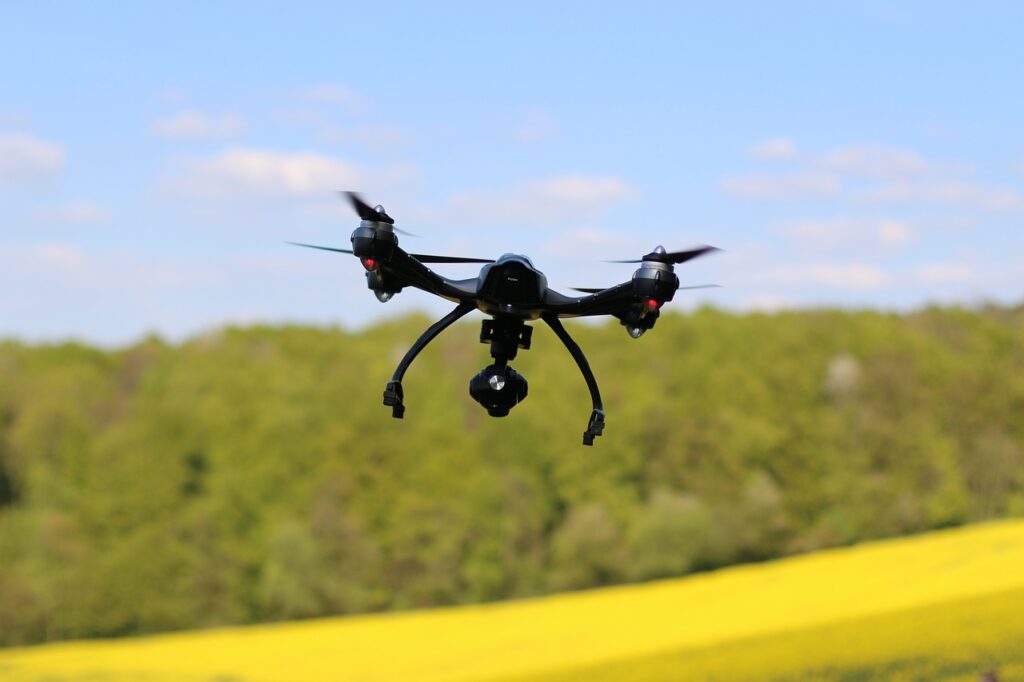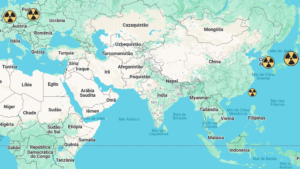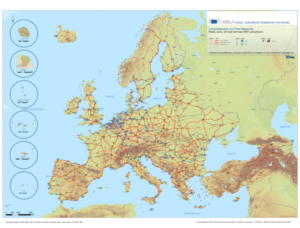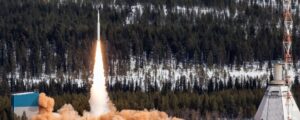- Low-cost drones are a strategic option that provides advantages to countries in conflict that have fewer resources.
- The efficient use of Ukrainian drones has reinforced debates in the United States about the role of military technology in modern geopolitics.
- Low-cost drones raise questions about the future of global conflicts and the ethical challenges associated with this form of combat.
In the skies over Ukraine, low-cost drones are changing the dynamics of warfare, offering Kiev a strategic advantage against Russia.
Consequently, the intense use of drones has reinforced the American strategy called Replicator, created to combat China’s military mass.
These aerial devices, initially designed for civilian tasks, now play a crucial role in surveillance, reconnaissance, attack and defense, triggering a global debate about the future of warfare.

What are low-cost drones and how can they be used?
Low-cost drones are unmanned aerial vehicles that can be produced relatively economically and affordably. They are made with lightweight materials such as plastic, aluminum, or carbon fiber and equipped with electric motors.
Low-cost drones have an impressive variety of ways they can be used. Here are some examples:
- Agricultural Monitoring: Drones can be equipped with cameras and sensors to monitor crop growth, detect pests and diseases, and even perform pesticide spraying more accurately and efficiently.
- Terrain Mapping: They can be used to map terrains and document information in hard-to-reach areas such as dense forests or mountainous regions.
- Package Delivery: Logistics companies are exploring the use of drones for delivering parcels in urban and rural areas, enabling fast and affordable deliveries, especially in remote locations.
- Infrastructure Inspection: Drones can also inspect infrastructures such as power lines, telecommunication towers, and bridges, providing detailed insights and identifying potential maintenance issues.
- Environmental Monitoring: They are useful for monitoring air and water quality, conducting surveys of fauna and flora, and even detecting forest fires.
- Search and Rescue: In emergency situations such as natural disasters or accidents, drones can also be used to locate and rescue lost or trapped individuals in hard-to-reach areas.
- Surveillance and Security: Public security agencies can use drones to monitor large events, patrol border areas, and assist in operations to search for criminals.
However, what has really caught attention is their role on the battlefield. Imagine hundreds, if not thousands, of these drones flying in formation, like a swarm of bees, each with a specific mission. Some are equipped with cameras for reconnaissance and target selection, while others carry explosives for precise attacks.
Their differentiator is that being cheap and disposable, they can be used in large numbers, overwhelming enemy defenses and paving the way for new military strategies.
How are drones leveling the battlefield and providing a strategic advantage for Ukrainian forces against Russia?
Two years ago, tensions between Russia and Ukraine escalated until Moscow invaded Ukrainian territory. Thousands of soldiers have lost their lives during this time.
Right at the beginning of the invasion, Kiev pulled a surprise move, and Ukrainians are not just fighting with tanks and soldiers. They have something new in their arsenal: drones.
In the case of Russia and Ukraine, often opponents at war have vastly different military capabilities, so we call this “asymmetric conflict” or “asymmetric warfare”. Asymmetric warfare doesn’t always involve two countries; it could be a terrorist group and a country, for example, like the United States against the Taliban, which is an armed group in Afghanistan.
If opponents have similar power, such as the United States and Russia, or the United States and China, it would be called “symmetric conflict” or “symmetric warfare”.
In this case, Russia is a much more powerful country in terms of military, economic, or technological terms than Ukraine, creating a power imbalance. Thus, in this type of war, the weaker side may use different strategies, such as guerrilla warfare, terrorism, cyber attacks, or, in this case, the use of drones to compensate for its weaknesses and challenge the stronger adversary.
In the same approach of asymmetric warfare against Russia, Ukraine sought to develop what it calls “the world’s first fleet of naval drones.” This effort revolves around an unmanned surface vessel, called “Sea Baby“, to launch surprise attacks against Russian warships.
Equipped with explosives, these small weapons have been employed effectively, exploiting weaknesses in the defense systems of Russian ships. This strategy not only highlighted Ukraine’s adaptability in asymmetric warfare but also emphasized the growing importance of low-cost and accessible technologies in contemporary military operations.
These drones in the sky and at sea have an important mission: to provide Ukrainians with a strategic advantage against the Russian army. In the sky, they fly silently, gathering vital information about Russian troop movements, identifying strategic targets, and even attacking them directly.
Equipped with high-resolution cameras and, in some cases, even weapons and explosives, these drones can strike enemy targets with lethal precision. This puts the Russians at a disadvantage since it is very difficult to hide from the vigilant eyes of Ukrainian drones.
These swarms of drones are leveling the battlefield in favor of Ukraine in several ways:
- Reconnaissance and Surveillance: They provide advanced reconnaissance and surveillance capabilities, allowing Ukrainian forces to monitor Russian movements and accurately identify strategic targets.
- Precision Strikes: They can be equipped with precise weaponry, allowing Ukrainian forces to effectively attack specific targets of Russian forces, minimizing collateral damage and maximizing military impact.
- Flexibility and Mobility: They offer Ukrainian forces greater flexibility and mobility on the battlefield, allowing them to adapt quickly to changes in the situation and effectively respond to Russian tactics.
- Affordable Cost: Low-cost drones allow Ukrainian forces to deploy a large number of them without incurring high costs, expanding their ability to conduct effective military operations against Russia in asymmetric warfare.
However, over time, the Russians also adapted and began using aerial drones on a large scale.
Therefore, the effectiveness demonstrated by the use of low-cost drones by Ukraine has encouraged the United States to accelerate the Replicator program, aiming at its application in future conflicts.
This initiative not only aims at potential attacks against other countries, including China but also seeks to learn how to develop effective defense mechanisms against these drones, recognizing the growing importance of these technologies in the increasingly modernized military sector.
The impact of Ukrainian drones on political and strategic discussions in the United States
The drones used by Ukraine are having a significant impact on political and strategic discussions already underway in the United States. They are seen as an example of the potential of new war technologies and how they can change the balance of power in geopolitical conflicts.
Here are some aspects of this impact:
- Revival of the Debate on the Use of Military Technology: It has reignited the debate on the role of military technology in the modern era, raising questions about how technological advancements can influence armed conflicts and national defense strategies.
- Recognition of the Effectiveness of Low-Cost Drones: The successful demonstration of Ukrainian drones has highlighted the effectiveness of low-cost systems in military operations, leading US political and military leaders to reconsider their investment strategies in military technology.
- Expansion of the Discussion on Military Assistance: There has been increasing pressure on the United States to provide additional military assistance to Ukraine, including the provision of more drones and training to operate them.
- Reflection on US Technological Competitiveness: Raises questions about US technological competitiveness in relation to countries such as Russia and China, highlighting the need for continued investment in research and development of military technology.
Strategists are also reconsidering their approaches to dealing with international threats, such as China. According to the Pentagon, it’s not just about gaining technological advantage, but rather a race against time.
According to Washington’s intelligence, Beijing has already militarized islands in the South China Sea, and Chinese President Xi Jinping has ordered his military to be ready to invade Taiwan by 2027.
The United States’ “Replicator” Initiative to deter China with drones using the Moneyball tactic
In a strategic move, the United States Department of Defense recently unveiled its new initiative, called “Replicator.” As a direct response to the growing competition with the People’s Republic of China, this ambitious initiative aims to rapidly enhance American military capabilities through the massive use of drones.
The first mission of the Replicator will be to scale up and deploy thousands of autonomous systems – drones that do not need human control, defining their targets on their own – within 18 to 24 months, starting from August 2023.
Combining artificial intelligence, robotics, and commercial technology, this project is the latest chapter in a series of efforts by the Department of Defense to transform advances in emerging technologies into ready-to-use resources.
Although the goal of enhancing military capabilities is certainly exciting, the Replicator has a second equally important objective: to transform how the Department of Defense conducts its weapon acquisition operations, overcoming the challenge known as the “Valley of Death“
In this zone, many innovative defense technologies end up stagnating during their development due to high costs and fail to be implemented economically on the battlefield. If the Replicator can overcome this obstacle, this achievement could be the true turning point of the initiative.
Behind this façade of technological innovation, there is a race against time to keep up with China’s efforts to “intelligentize” its armed forces while lowering the cost of acquiring efficient weapons. The goal is clear: to prevent China from gaining geopolitical advantage in the Indo-Pacific region through low-cost but efficient armaments.
This strategy, sometimes called “Moneyball military“, originates from baseball, which involves using statistics and data analysis to find undervalued players who can significantly contribute to the team’s success, often at a lower cost than more renowned players.
Relating this to the military sector in a simple way, imagine that in a battle, the available resources are like players on a baseball team. Just as Moneyball seeks to find players with good performance undervalued, the military concept seeks to identify technologies or strategies that can be highly effective but may not be the most traditional or expensive like existing complex weapon systems.
In the case of the Replicator, it would be the massive use of drones for their low cost, but high efficiency and effectiveness. This allows military forces to maximize their resources, achieving maximum impact with the least possible investment. For example, it is common to see in the Ukrainian conflict, civilian drones used by Ukraine that cost around $300 destroying Russian tanks that cost over $4.5 million.
However, while the spotlight is on the Replicator as a futuristic and more economical solution, concerns are emerging behind the scenes. Some question whether the proposed changes are sufficient to address immediate challenges.
There is fear that the Department of Defense may get stuck in a cycle of slow progress, risking falling behind in an era of rapid technological evolution.
What is the role of low-cost drones in the future of global conflicts?
The role of low-cost drones in the future of global conflicts is a subject of growing interest and concern. While this technology promises to democratize access to military defense and provide significant tactical advantages to actors with fewer resources, it also brings challenges and risks.
On one hand, low-cost drones have the potential to level the battlefield, allowing countries with limited resources to defend themselves against more powerful adversaries. That is, turning asymmetric conflicts into more symmetric conflicts (on equal terms). This can be seen in the conflict between Ukraine and Russia, where drones have played a crucial role in Ukrainian defense.
However, they can also be used against the US, which has the most powerful military arsenal on the planet but may become vulnerable to low-cost drones used by theoretically weaker actors and countries.
Thus, the increased use of these technologies also raises concerns about security and global stability. The low cost and availability of these drones can facilitate their use by non-state actors, such as militias and terrorist organizations, increasing the complexity and unpredictability of conflicts.
Therefore, the rapid technological evolution of drones means that their capabilities are constantly developing, making it difficult to predict and control their impact on future conflict scenarios.














Be First to Comment